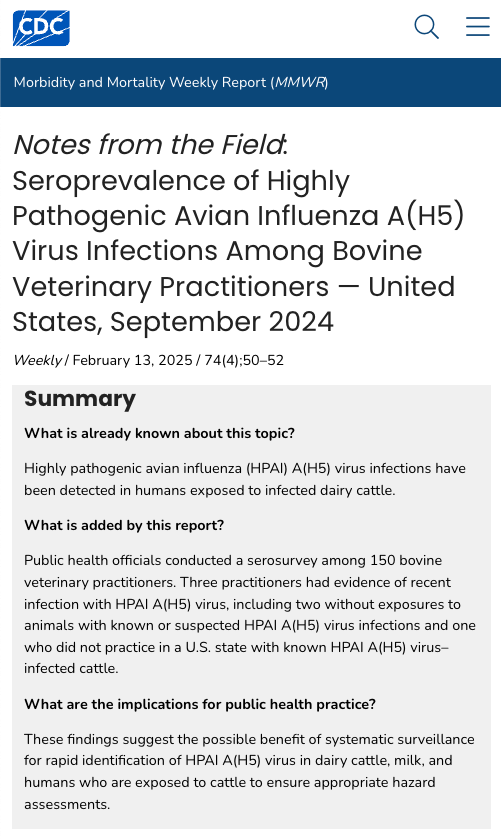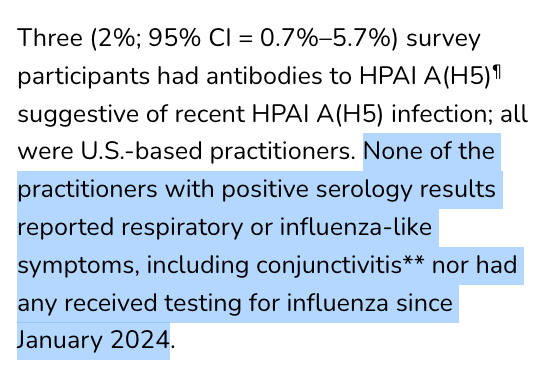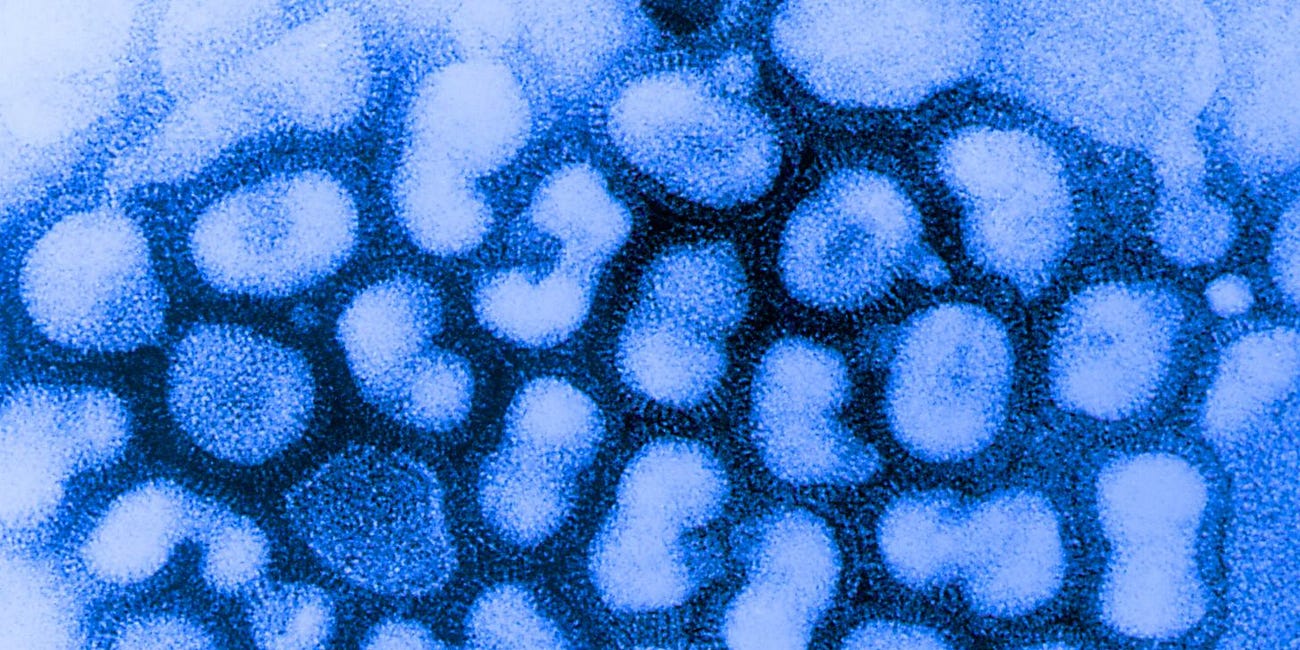Gates-Funded CDC Survey Bribes Symptomless Cow Veterinarians with $50 Gift Cards to Be Tested for Bird Flu
Despite low antibody detection possibly attributable to false positives or passive immunity, U.S. agency pushes expanded testing and surveillance, fueling concerns over inflated H5N1 case numbers.
A recent publication in the CDC’s Morbidity and Mortality Weekly Report (MMWR) confirms the agency is bribing bovine veterinary practitioners with $50 gift cards in return for samples of their blood to be tested for H5N1 avian influenza “bird flu” antibodies.
Follow Jon Fleetwood: Instagram @realjonfleetwood / Twitter @JonMFleetwood / Facebook @realjonfleetwood
However, instead of acknowledging the inherent limitations of antibody testing and the absence of clinical illness among the veterinarians, the report promotes expanded surveillance efforts, which could further misrepresent the true prevalence and significance of H5N1 in cattle populations.
One of the report authors, Samantha M. Olson, received financial support from the Gates Foundation.

The serosurvey, approved by the Ohio Department of Health institutional review board, aimed to “investigate the prevalence of recent HPAI A(H5) infection among U.S. bovine veterinary practitioners,” the publication reads.
“Participation was anonymous, and participants received a $50 USD gift card as compensation after the blood draw.”
A total of 150 surveyed practitioners were tested for antibodies to bird flu infection.
Only three veterinarian survey participants (2%) are said to have tested positive for antibodies to bird flu.
Despite such a low figure being attributable to false positives or passive immunity, the Gates-funded report claims the antibody results are “suggestive of recent HPAI A(H5) infection.”
Given the limitations of serological testing, a 2% positivity rate could easily fall within the expected margin of error for false positives, especially considering the sensitivity and specificity challenges inherent in antibody assays.
Additionally, the presence of antibodies does not necessarily indicate active or prior infection, as passive immunity—acquired through environmental exposure or cross-reactivity with other influenza strains—could account for the detected antibodies.
In fact, the CDC report confirms that “none” of the vets who tested positive had any symptoms of illness, lending support to the possibility that these antibody detections were either false positives or the result of passive exposure rather than actual infection.
None of them felt sick enough to get tested for bird flu either.
“None of the practitioners with positive serology results reported respiratory or influenza-like symptoms, including conjunctivitis nor had any received testing for influenza since January 2024,” the publication reads.
None worked with dairy cattle with known or suspected bird flu infection.
And all of the vets reported wearing gloves or a clothing cover when providing care to cattle.
Instead of explaining the possibility these antibodies could be attributable to false positives or passive immunity, the authors jumped to the conclusion that there must be even more infections in cows that are going undetected.
“These findings suggest that there might be HPAI A(H5) virus–infected dairy cattle in states where infection in dairy cattle has not yet been identified,” they claim.
The authors assert this means there should be more testing.
They say the findings highlight “the importance of rapid identification of infected dairy cattle through herd and bulk milk testing.”
But if these test results are the result of false positives or passive immunity, then increasing testing could lead to an inflated perception of H5N1 spread, driving unnecessary alarm and policy responses based on flawed data rather than actual epidemiological risk.
Which raises the question: is this about public health, or manufacturing a narrative to justify more surveillance and intervention?
Follow Jon Fleetwood: Instagram @realjonfleetwood / Twitter @JonMFleetwood / Facebook @realjonfleetwood
Prevalence of False Positives
A study published in Nature Scientific Reports in 2021 found that in regions with 1% disease prevalence, the upper limits of false positive antibody rates for 74% of the examined tests exceeded 60%.
This means that in low-prevalence areas, more than half of positive antibody test results could be false positives.
Research from the National Health and Nutrition Examination Survey (NHANES) revealed that in a population with 1% hepatitis C virus (HCV) infection prevalence, about 22% of anti-HCV positive results were false positives.
This demonstrates how low disease prevalence, which is currently the case for bird flu, can lead to a high proportion of false positive results.
Finally, a Cochrane review on COVID-19 antibody tests showed that if 1,000 people were tested in a population where 5% had COVID-19, about 12 people would receive false positive results.
This translates to a false positive rate of 1.2% in the general population, but more importantly, it means that 21% of positive results would be false positives.
The 1.2% figure refers to the false positive rate among people without COVID-19 (12 false positives out of 950 uninfected people).
The 21% figure represents the proportion of false positives among all positive test results (12 false positives out of 62 total positive results).
In a population with low disease prevalence, even a small percentage of false positive test results can constitute a large proportion of the total positive results, potentially leading to significant misinterpretation of the true infection rate.
Follow Jon Fleetwood: Instagram @realjonfleetwood / Twitter @JonMFleetwood / Facebook @realjonfleetwood
147 Million Poultry Slaughtered Since 2022—Culled, Not Killed by Bird Flu
The U.S. government has mandated the mass culling of poultry, leading to the loss of a record 147.25 million birds across all 50 states and Puerto Rico since 2022.
Trump to Ban Gain-of-Function Research Funding—Except for Bird Flu: WSJ
President Donald J. Trump’s administration is preparing an executive order that would at least temporarily halt federal funding for deadly gain-of-function (GOF) experiments that make pathogens more dangerous to humans.
U.S. Pumps Another $306 Million Into Bird Flu Pandemic Efforts
On Friday, the U.S. Department of Health and Human Services (HHS) announced it would award $306 million to continue its H5N1 avian influenza “bird flu” response.
California Declares Bird Flu State of Emergency
California Governor Gavin Newsom today proclaimed a State of Emergency in response to H5N1 avian influenza “bird flu,” following dozens of reports from this website warning readers of a potentially incoming, orchestrated H5N1 avian influenza pandemic.
FDA Greenlights New Bill Gates-Funded ARCT-2304 Self-Replicating samRNA 'Pandemic' H5N1 Bird Flu Jab
Arcturus Therapeutics, a company specializing in mRNA-based pharmaceuticals, quietly announced Monday that the U.S. Food and Drug Administration (FDA) has granted approval for its Investigational New Drug (IND) application for ARCT-2304, a self-amplifying mRNA (sa-mRNA) injection targeting the H5N1 avian influenza “bird flu” virus.
FDA to Skip Drug Approval Process for Bird Flu Vaccine: Dr. Peter Marks Confirms Agency Will Leverage Controversial 'Emergency Use Authorization' (EUA) Tactic as It Did with Deadly COVID Jab
Dr. Peter Marks, Director of the Center for Biologics Evaluation and Research (CBER) at the U.S. Food and Drug Administration (FDA), confirmed last week that the FDA will skip the rigorous drug approval process for influenza bird flu (H5N1) vaccines, as it did for COVID-19 jabs.
U.S. Gov't Manufactures Bird Flu PCR Test In-House Without Third-Party Oversight
The United States government has come under scrutiny for manufacturing the bird flu PCR test in-house without third-party oversight, raising concerns about the accuracy and reliability of the tests as well as their purpose.












Inflated false positives is what they want. It is what they did with COVID too. Like Dr. Mullis said if you cycle PCR enough times you can obtain whatever result you want. He also said PCR cannot detect illness. Antibodies only means the animal may have come in contact with bird flu in their lifetime. It surely doesn't mean they are sick or contagious. This is a direct and planned attack on our food source. One of the goals of UN Agenda 21 is to get rid of all large hoofed animals, paddocks, fencing, modern agricultural equipment and much more. The UN Global Biodiversity Assessment lists all the things that must be ended......private property, ski slopes, dams, population growth, consumerism just to name a few more on the list. There is a lot more.
Uh-oh. Now it becomes a question of morality. Do any of these vets have any?